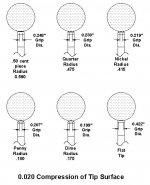Most cues I've tried have a 13 or 12.75 tip diameter. My venom shaft has a 13.
I know that smaller tip diameter means more spin control, but less accuracy(Unforgiving) and a bigger tip diameter means more accuracy, but less spin control... But can someone go into more depth on this?
Have you played an extensive period of time with both a 12.75/13 mm shaft and a 11.75 mm shaft? How different is 12.75 and 13? What about 11.75 or lower?
Predator 314 2 vs Z 2?
I know that smaller tip diameter means more spin control, but less accuracy(Unforgiving) and a bigger tip diameter means more accuracy, but less spin control... But can someone go into more depth on this?
Have you played an extensive period of time with both a 12.75/13 mm shaft and a 11.75 mm shaft? How different is 12.75 and 13? What about 11.75 or lower?
Predator 314 2 vs Z 2?
